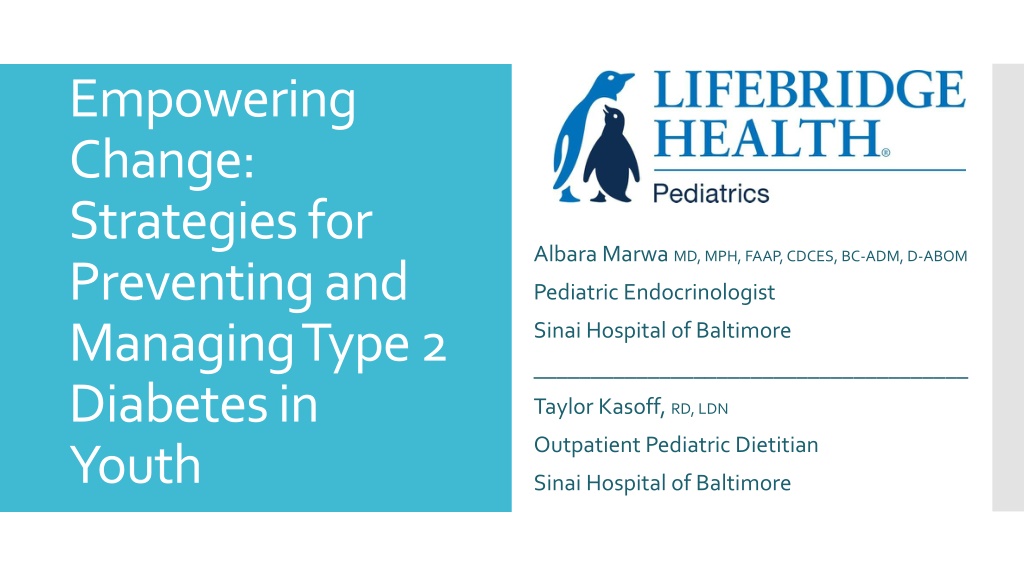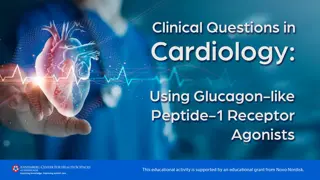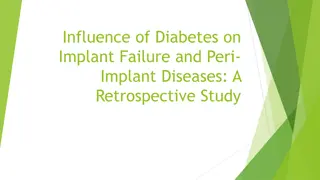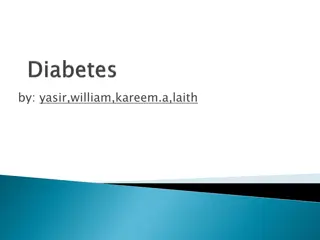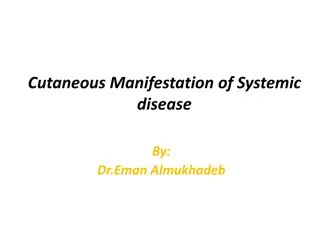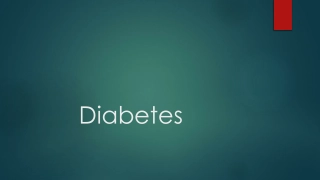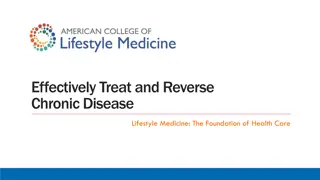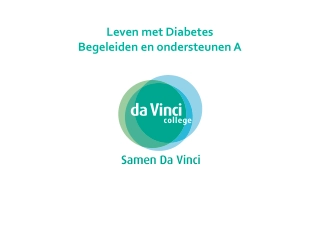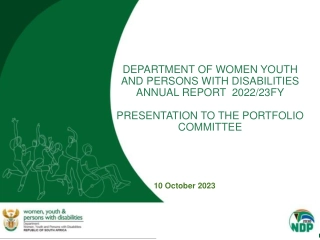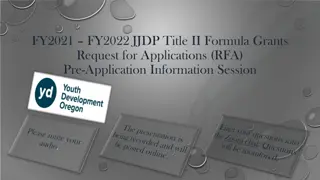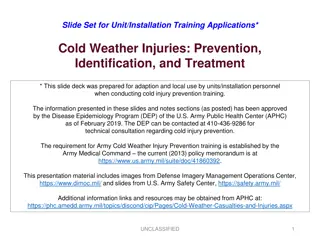Preventing and Managing Type 2 Diabetes in Youth
Strategies for preventing and managing type 2 diabetes in youth are discussed in this informative presentation by Dr. Albara Marwa and Taylor Kasoff. Participants will learn about the prevalence, risk factors, prevention strategies, and collaborative management approaches related to pediatric obesity and type 2 diabetes. The session aims to empower healthcare professionals with the knowledge to create personalized management plans for patients and enhance long-term health outcomes.
Download Presentation
Please find below an Image/Link to download the presentation.
The content on the website is provided AS IS for your information and personal use only. It may not be sold, licensed, or shared on other websites without obtaining consent from the author. Download presentation by click this link. If you encounter any issues during the download, it is possible that the publisher has removed the file from their server.
Presentation Transcript
Empowering Change: Strategies for Preventing and Managing Type 2 Diabetes in Youth Albara Marwa MD, MPH, FAAP, CDCES, BC-ADM, D-ABOM Pediatric Endocrinologist Sinai Hospital of Baltimore ______________________________________ Taylor Kasoff, RD, LDN Outpatient Pediatric Dietitian Sinai Hospital of Baltimore
Disclosures Nothing to disclose We will not discuss off-label treatment
Understand the Current Landscape: Participants will be able to recognize the prevalence and risk factors associated with pediatric obesity and type 2 diabetes, and explain the implications for long-term health outcomes. Prevention Strategies: Attendees will learn to describe effective prevention strategies, including lifestyle modifications, community-based interventions, and medications, to reduce the incidence of type 2 diabetes in youth Objectives Management and Collaboration: Participants will be able to discuss the role of multidisciplinary teams, including nutritionists and endocrinologists, in creating personalized management plans for patients, and analyze the impact of these collaborations on patient outcomes.
Definition and differences from type 1 diabetes Epidemiology and trends in youth Risk factors and early signs Understanding Type 2 Diabetes
Source: National Institute of Diabetes and Digestive and Kidney Diseases
Centers for Disease Control and Prevention. (2022, August 11). A snapshot: Diabetes in the United States. https://www.cdc.gov/diabetes/library/socialmedia/infographics/diabetes.html Reference to specific commercial products, manufacturers, companies, or trademarks does not constitute its endorsement or recommendation by the U.S. Government, Department of Health and Human Services, or Centers for Disease Control and Prevention. The material is otherwise available on the CDC website for no charge.
Centers for Disease Control and Prevention. (2022, August 11). A snapshot: Diabetes in the United States. https://www.cdc.gov/diabetes/library/socialmedia /infographics/diabetes.html Reference to specific commercial products, manufacturers, companies, or trademarks does not constitute its endorsement or recommendation by the U.S. Government, Department of Health and Human Services, or Centers for Disease Control and Prevention. The material is otherwise available on the CDC website for no charge.
Centers for Disease Control and Prevention. (2022, August 11). A snapshot: Diabetes in the United States. https://www.cdc.gov/diabetes/library/socialmedia/infographics/diabetes.html Reference to specific commercial products, manufacturers, companies, or trademarks does not constitute its endorsement or recommendation by the U.S. Government, Department of Health and Human Services, or Centers for Disease Control and Prevention. The material is otherwise available on the CDC website for no charge.
Type 2 Diabetes is Aggressive in Youth N Engl J Med 2021; 385:416-426
Early Signs and Associated Conditions Insulin Resistance Acanthosis nigricans High Blood Pressure High Cholesterol Polycystic Ovarian Syndrome Being Overweight This Photo publihsed at https://thuocdantoc.vn/wp-content/uploads/2023/04/benh-gai-den-3.jpgis licensed under CC BY-S
Children and adolescents who are overweight ( 85th percentile) or obese ( 95th percentile) and exhibit one or more of the following risk factors: oMaternal history of diabetes or gestational diabetes during gestation oFamily history of type 2 diabetes in a first- or second-degree relative oRace/ethnicity: Native American, African American, Latino, Asian American, Pacific Islander oSigns of insulin resistance: Acanthosis nigricans, hypertension, dyslipidemia, polycystic ovary syndrome, small-for- gestational-age birth weight Whom to screen? American Diabetes Association Professional Practice Committee; 2. Diagnosis and Classification of Diabetes: Standards of Care in Diabetes 2024. Diabetes Care 1 January 2024; 47 (Supplement_1): S20 S42. https://doi.org/10.2337/dc24-S002
When to Start Screening: After the onset of puberty or after 10 years of age, whichever comes first. Testing Frequency: At least every 3 years, with adjustments based on BMI changes or worsening risk profiles. Note: Early screening may be warranted for children under 10 with multiple risk factors or in cases of reported type 2 diabetes before age 10. How to Implement Screening? American Diabetes Association Professional Practice Committee; 2. Diagnosis and Classification of Diabetes: Standards of Care in Diabetes 2024. Diabetes Care 1 January 2024; 47 (Supplement_1): S20 S42. https://doi.org/10.2337/dc24-S002
Early Signs and Associated Conditions
Centers for Disease Control and Prevention. (2022, December 30). Type 2 Diabetes is a Rising Threat in Youths. https://www.cdc.gov/diabetes/library/socialmedia/infographics/diabetes-youth-threat.html Reference to specific commercial products, manufacturers, companies, or trademarks does not constitute its endorsement or recommendation by the U.S. Government, Department of Health and Human Services, or Centers for Disease Control and Prevention. The material is otherwise available on the CDC website for no charge.
Insulin Resistance: Obesity increases the risk of insulin resistance, a precursor to Type 2 Diabetes. Lifestyle Factors:Poor diet, physical inactivity, and sedentary behavior in contributing to obesity and Type 2 Diabetes. Link between Childhood Obesity and Type 2 Diabetes
This Photo published by Wikimedia Commonsis licensed under CC BY-SA.
Role of lifestyle modifications: diet, exercise, sleep Importance of early intervention Prevention Strategies Community and school- based initiatives Medications
3-5 y.o.Should be active for at least 3 hours a day CDC Pysical Acitivty Guidelines 6-17 y.o. Should be active for at least 1 hour a day with moderate to vigorous activity Move MORE and Sit LESS
Long Term Effects of Physical Activity Improve cognition, decrease risk of depression Reduce risk of excessive weight gain Help manage pain for osteoarthritis, reduce progression of HTN, T2DM, reduce symptoms of anxiety, depression, and ADHD
The talk testis a simple way to measure relative intensity. In general, if you re doing moderate-intensity activity, you can talk but not sing during the activity. Walking briskly (3 miles per hour or faster, but not race- walking) Water aerobics Bicycling slower than 10 miles per hour on primarily flat or level terrain without hills Tennis (doubles) Ballroom dancing General gardening Moderate Intensity According to the CDC
In general, if youre doing vigorous-intensity activity, you will not be able to say more than a few words without pausing for a breath. Race walking, jogging, or running Swimming laps Tennis (singles) Aerobic dancing Bicycling 10 miles per hour or faster that may include hills Jumping rope Heavy gardening (continuous digging or hoeing) Hiking uphill or with a heavy backpack Vigorous Intensity According to the CDC
Emotional and mental health considerations Addressing stigma and building support networks Importance of family involvement and communication Psychosocial Aspects of Diabetes Management
More than 1 component may affect Blood sugar control. Provider should empower the patient rather than "blame" for poor adherence to diabetes recommendations. Psychosocial Care About 1/3 of adolescents w/ DM develop diabetes distress... leading to poor blood glucose management
Potential reasons for poor blood diabetes control: oWorsening disease oLow health literacy oLow reading level oPoor diabetes education oLack of routine oPoor social support oInaccurate beliefs in the diagnosis or medicine oDepressive symptoms oFinancial Factors Psychosocial Care
Annual screenings for depression, anxiety disorders, disordered eating behaviors, and other mental illness Psychosocial Care
PHQ-9A Modified with permission by the GLAD-PC team from the PHQ-9 (Spitzer, Williams, & Kroenke, 1999), Revised PHQ- A (Johnson, 2002), and the CDS (DISC Development Group, 2000)
- Any stressors at home/school Things to look for during assessment for social factors - Access to food - Family Hx of Diabetes - Who is managing the Diabetes care? How old is the pt? - Home Responsibilities
What do you think is ONE of the MOST challenging parts of diabetes Management is?
General Recommendations Decrease overall energy intake Decrease saturated fat intake Increase Fiber Intake Cut out sugary/sweetened beverages Daily Intake Breakdown: 45-55% calories from carbs 15-20% calories from protein <25% calories from fat 5-10% daily calories coming from saturated fat (2,000 calories = 10-20g sat fat)
Carbs, protein and fat are the three biggest nutrients that make up what we eat Carbs have the biggest affect on our blood sugars While you need to eat carbs to survive, it is important not to eat too many carbs Eating too many carbs can lead to weight gainand high blood sugars (hyperglycemia) Carbohydrates Carbs are found in a variety of foods including: Grains: bread, pasta, crackers, cereal, rice, etc Fruits Starchy vegetables: potatoes, corn, peas, etc Dairy: milk, yogurt, etc Sugar: juices, soda, fruit drinks, cakes, cookies, candy, dessert
McDonalds Medium French Fries + Classic Hamburger Chick Fil a Spicy Southwest Salad What has more Sat Fat.?
What has more carbs? Snack Pack of Chips Ahoy vs 3 cups of Popped Popcorn
What has more Fiber 1/2 Cup of Granola vs 1 box of Raisins
What has more CARBS 1/2 Cup of Granola vs 1 box of Raisins
What has more fiber? 1 box Raisins vs 1 apple
Specific Measurable Attainable/Achievable Realistic/Relevant Timeline SMART GOALS
I will choose Skinny Pop instead of Takis on Mondays and Wednesdays in order to decrease myLDL by 20 units in 6 months.
Nutrition Facts Label This Photo by is licensed under CC BY. This Photo by Wikimedia Commons is licensed under CC BY-SA.
Use smaller plates/bowls at meals oSecond helpings should be protein + non- starchy vegetables Get Kids involved with cooking Do not use Food as Positive Reinforcement Meals together as a family Eat meals without distractions Quick Tips
Drink more water Caregivers decide what is on the menu for meals and the children decide how much or little they want to eat from their plate Out of Mind Out of Sight- Snacks should be poured onto a plate/cup/napkin instead of eaten from the large container Lean Meats (97% lean ground meat, white meat of poultry, lower fat cuts of meat), fish, beans, low-fat dairy Decrease Consumption of processed snacks Quick Tips
Medications for Weight Loss
Indication: Obesity in children aged 12 and older. Helps in reducing appetite and increasing feelings of fullness. Can lead to significant weight loss (AVG 7% BMI decrease) when combined with a reduced-calorie diet and increased physical activity. Common Side Effects: Dry mouth, constipation, tingling in hands/feet, altered taste sensation, Sleep concerns. FDA- Approved Medication for Obesity Management: Phentermine &Topiramate Combination Kelly AS, Bensignor MO, Hsia DS, Shoemaker AH, Shih W, Peterson C, Varghese ST. Phentermine/Topiramate for the Treatment of Adolescent Obesity. NEJM Evidence. 2022;1(6):EVIDoa2200014. doi: doi:10.1056/EVIDoa2200014.
Mimics the action of GLP-1, a hormone that regulates appetite and food intake, leading to reduced hunger and calorie intake. FDA Approved for use in children aged 12 and above with obesity. (Approved for 10 and older with diabetes) Estimated Weight Loss: Studies have shown a significant reduction in BMI and body weight in adolescents. (AVG 16% BMI reduction with semaglutide) Common Side Effects: Nausea, vomiting, diarrhea, abdominal pain, decreased appetite. FDA- Approved Medication for Obesity Management: GLP-1 Agonists (Liraglutide, Semaglutide) Weghuber D, Barrett T, Barrientos-P rez M, et al for the STEP TEENS Investigators. Once-Weekly Semaglutide in Adolescents with Obesity. N Engl J Med. 2022 Dec 15;387(24):2245-2257. PMID: 36322838.
Medical Management of Type 2 Diabetes in Youth Lifestyle modifications Medication options and monitoring Regular check-ups and long-term care
This Photo published by Frontiers is licensed under CC BY.
Liraglutide GLP-1 agonists approved for pediatric Type 2 Diabetes 10 years and older Exenatide Dulaglutide
